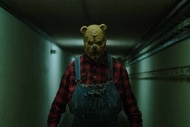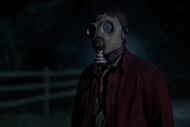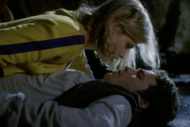Create a free profile to get unlimited access to exclusive videos, sweepstakes, and more!
Stranger Things 3: Eleven's gnarly Mind Flayer wounds and other makeup secrets

In the beginning, the majority of the cuts and bruises the Stranger Things kids endured were just that — simple scrapes and bloody noses that any kid not fighting an extra-dimensional monster might suffer on the school playground. But as the Netflix series has gone on, each season growing in scale and leveling up like a video game, the injuries have gotten increasingly supernatural and brutal.
Stranger Things 3 results in a collection of new and horrifying injuries and ailments for the Hawkins gang, including truth serum sickness, black eyes, black veins, and sludge-ification. Perhaps the most memorable addition, though, comes in the form of Eleven's gnarliest wound yet, an infected cut to the leg that she suffers while fighting off a screaming, fleshy monster in the cabin she lives in with Hopper (David Harbour). Over the course of an episode, this wound swells, festers, and grows a miniature Mind Flayer just under the surface, all of which results in a gag-worthy, on-the-ground surgery performed by teenagers.
The person charged with making Eleven's wound as gory and gushing as physically possible (and with wrangling every other onscreen scrape along the way) was Stranger Things' Emmy-nominated makeup department head Amy L. Forsythe. Working in tandem with the costume designer and stunt coordinator, as well as the post-production special effects wizards and Lone Wolf Effects makeup Fx lab, Forsythe and her team spent less than a month working their way through the finer points of "blood and sweat and goo and what have you."
"I started printing out all these different wound options that I fell in love with, and based on those, I would figure out the steps," Forsythe tells SYFY WIRE. After studying how real infections spread and how real animal bites and claw marks tear at human skin, Forsythe would turn to the portable printer she kept on set to test out how certain designs looked.
"I printed out all of these wounds and I had somebody on my team go out and buy some mannequin legs," Forsythe says, laughing. "They thought I was crazy! 'Guys, you know what I really need? I need some mannequin legs … you'll get it, you'll understand when I have it.'"
As she explored different wound angles, sizes, and shapes, Forsythe had countless discussions with other teams: with the stunt team to see what direction the rig would be pulling Eleven actor Millie Bobby Brown as well as the visual effects team to see what kind of claws the Mind Flayer's spawn would be sporting. It turns out bear claws are the closest real-world equivalent.
After all her research, tinkering, and mannequin testing, Forsythe brought the designs for Eleven's leg injury to the Duffers. While some of Forsythe's initial designs had been less gruesome — shallower cuts and less pus — the final results were, in a word, sickening — in the best way possible. The Duffers were thrilled, though initially taken aback by the results they'd inspired.
In fact, Forsythe and her team had gone so deep and detailed that very little needed to be added in post-production; in the end, the visual effects crew only added the wriggling mini-Flayer underneath and some black veining. Everything else — the blood, the pus, the swelling — was practical effects attached to Brown and her double's legs.
The same could be said for Forsythe's other biggest Season 3 challenge: Billy Hargrove's collection of scrapes, cuts, and bruises. When it was all said and done, at his most banged-up moments, Billy actor Dacre Montgomery was sporting 33 separate prosthetics, all of which had to be done up in a convincingly gory manner.
"And we had to replicate that on his photo double, and we had to replicate that on his stunt double," Forsythe says. "So there were certain [scenes when] we had 99 prosthetics [to work on] ... It's ridiculous."
Because so much of the script was up in the air or uncertain until later in the game, Forsythe and her team were on a tight schedule, resulting in last-minute changes.
"Especially with the Dacre wounds, because we had to establish them in a kind of sloppy, haphazard way," Forsythe says. "If we had had enough time, I could have made bigger silicone pieces that were pre-painted and slap them on him and it would have been less time in the chair, less hassle for him, less opportunity for them to get messed up throughout the day. But as it stood, we were tethered to these prosthetic transfers.
"They're made out of glue. And it's the summer, in Georgia," she continues, laughing. "Someone came and got me one day at lunch and they're like 'Amy, um, can you come to lunch? Dacre's stuck to the tablecloth.' Dacre had been talking to people and was leaning on his right arm, and the elbow piece and the wrist piece were glued to the tablecloth."
As she points out, behind-the-scenes artists are expected to improvise and problem-solve as they go along, whether it's freeing actors from tablecloths using cotton swabs and rubbing alcohol or pivoting for a last-minute change to the script.
Forsythe and her team asked early on about whether the Flayed's blood should be black instead of red, given the black veins. Originally, the Duffers decided on red.
"So we establish all of [Billy's] wounds bleeding red, and then they're like, 'You know what?'" Forsythe says, laughing. "And I'm like, 'Oh, my god, you guys are killing me.' And they're like, 'Yeah, we actually do want him to bleed black.'" Because several scenes in which Billy bleeds red had already been shot, the blood color in those scenes had to be changed in post-production.
"TV is so different from film," Forsythe continues. "With film, you get the entire script … you can have everything lined up — if things move around, you're prepared for anything. Whereas with TV you're getting the script as you go. And it's sci-fi, so these rules don't exist [in the real world]; we're making them up. So it's like whatever we're making up might carry over into the next season or it might come back the following season, so we have to make sure we're setting rules for a world that are going to make sense and stick."




























